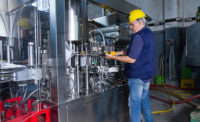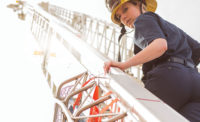The holiday season is here, and managers in the manufacturing, distribution and retail industries are hiring temporary workers to meet higher consumer demand. Physically demanding industries, including construction and manufacturing, show a much higher than average turnover rate. With an average turnover rate of 419% for temporary workers, organizations in physically demanding industries need to prioritize strategies that encourage seasonal employees to safely complete their contract. Lack of retention hurts organizations financially, with a typical employee who leaves the company costing the equivalent of six to nine months of their salary.
By helping the team adapt to these strenuous jobs, seasonal worker satisfaction and productivity levels can better meet expectations during the busiest season.
Utilize machine assistance
Successfully implementing ergonomic tools can adapt the work environment to the employee instead of asking the employee to adapt to the workplace. Because seasonal workers may not be as adjusted to the demands required in certain jobs, any technology that can mitigate the physical toll is likely to help reduce turnover for the temporary team. Adopting automation tools that limit repetitive movement, which is often a cause of musculoskeletal disorders (MSDs), is an effective way to enhance workplace ergonomics without requiring additional manpower. Vacuum lifts, tilted pick trays, and self-leveling lift tables are all examples of technology that can be implemented to decrease ergonomic risks for seasonal (and permanent) workers, which can increase workforce retention. These tools decrease the physical strain put on the employee.
The impact of simple changes
When looking at ways to assist workers in adjusting to the physical demands of these jobs, let’s tackle the number one cause of MSDs for logistics workers: overexertion from moving and lifting goods. More than one million back injuries are sustained in the workplace annually and those injuries are associated with a higher mortality rate. They also cost organizations thousands of dollars per case, and employees are often subjected to a lifetime of pain and limited opportunities.
The good news is that even small adjustments can make a noticeable reduction in injury risk, with one study finding that a 10% reduction in peak forces (muscle strain) results in up to an 80% reduction in microdamage to tissue. While many organizations have tackled basic ergonomic improvement programs by implementing lift tables or similar devices, there are often many tasks which are more difficult to address. Thankfully, there is a new suite of tools that have entered the market in the last decade that help address some of those remaining challenges.
The latest in ergonomic technology
Exoskeletons and exosuits are utilized around the world to mitigate injury risk by reducing muscle force during strenuous activities. For example, a back-assist exosuit can drastically reduce muscle strain and spine compression. And while a good exosuit shouldn’t restrict freedom of movement, many users find that they encourage proper lifting technique. These adjustments can improve how an employee feels during and after a shift, enhancing their ability to perform day-to-day operations and improving their quality of life away from the job - which has a big impact on worker retention.
The basics of exoskeleton technology
When looking at exoskeletons and exosuits, you’ll find there are two approaches to offering assistance with an exoskeleton: motorized (or powered) and elastic (or passive). A motorized exosuit relies on electronics (which are heavier and must be charged) to power the technology while elastic suits take their power from springs or elastic bands. Interestingly, motorized suits have not been found to provide more assistance to workers than elastic suits in peer-reviewed studies. The limits of assistance are more about user comfort than the source of power.
Another key difference in exoskeleton models is the design approach: rigid or soft. Rigid exoskeletons use a metal or hard plastic frame and are typically less flexible than soft exoskeletons (known as ‘exosuits’). Soft exosuits offer more flexibility and are usually lower profile, allowing the user to move in and out of tight spaces without constraint. This is especially important in physically demanding environments where employees need the flexibility to complete physical tasks, like operating forklifts. They also offer greater compatibility with other PPE such as fall protection.
When looking to introduce new ergonomic technology, the workforce’s daily operations must be considered. Companies have to be knowledgeable of the different body types of their temporary and seasonal workforce, and interventions must adjust to that population. And of course, any intervention must be manageable or it will create operational friction that reduces effectiveness and adoption. For exosuits, training and fitting workers has to be a simple and quick process, and the suits need to adapt to the size and shape of the workers that season.
Updating safety training
Providing proper training for temporary workers sometimes seems like a daunting task but it’s a necessary step to ensure they maintain productivity levels while avoiding injuries. The relationship between safety training and employee retention may not seem obvious; but if an employee is injured - or fears they might be - they might not return back to work. One survey of truck drivers found that the overall environment of safety culture was as important as actual perceived risk of injury. The safety climate of an organization, which is the degree to which safety is perceived by employees to be a priority in the company, is directly related to the objective turnover rate. By equipping employees with the safety training they need, they are likely to be more satisfied with their job and less likely to leave before the end of their contract.
There are many important elements to train new employees on: utilization of personal protective equipment (PPE), emergency responses, machine safety, and fall protection, etc - so much, that often simple things like proper lifting techniques can be easily overlooked. But by including ergonomic tools like exosuits, you can use the opportunity to reinforce the importance of technique in keeping workers safe. It is critical though, that whatever new tools are introduced are intuitive and easy for workers to operate, given the limited training opportunities.
During the most demanding season of the year, it’s easy to lose sight of ensuring adequate resources for temporary workers. By adopting ergonomic technology, adjusting the workplace to meet employee needs, and providing proper training, the company sets seasonal workers up for success, which can increase retention and reduce potential injury risk.



